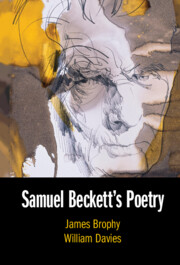Book contents
- Samuel Beckett’s Poetry
- Samuel Beckett’s Poetry
- Copyright page
- Contents
- Notes on Contributors
- Acknowledgements
- Abbreviations
- Introduction
- Chronology of Samuel Beckett’s Poetry
- Chapter 1 Weirdness and Dislocation in Beckett’s Early Poetry
- Chapter 2 Whole Fragments
- Chapter 3 Pre-echoing the Bones
- Chapter 4 ‘The Nucleus of a Living Poetic’
- Chapter 5 Beckett Growing Gnomic
- Chapter 6 Gender, Pronoun and Subject in ‘Poèmes 1937–1939’
- Chapter 7 The Missing Poème
- Chapter 8 Romanticism and Beckett’s Poetry
- 9 Romance under Strain in ‘Cascando’
- Chapter 10 Samuel Beckett’s Self-Translated Poems
- Chapter 11 Samuel Beckett’s Translations of Mexican Poetry
- Chapter 12 Beckett’s Poetry and the Radical Absence of the (War) Dead
- Chapter 13 Beckett’s Sound Sense
- Chapter 14 The Matter of Absence
- Chapter 15 ‘Mocked by a Tissue That May Not Serve’
- Chapter 16 Invoking Beckett
- Index
Chapter 6 - Gender, Pronoun and Subject in ‘Poèmes 1937–1939’
Published online by Cambridge University Press: 15 December 2022
- Samuel Beckett’s Poetry
- Samuel Beckett’s Poetry
- Copyright page
- Contents
- Notes on Contributors
- Acknowledgements
- Abbreviations
- Introduction
- Chronology of Samuel Beckett’s Poetry
- Chapter 1 Weirdness and Dislocation in Beckett’s Early Poetry
- Chapter 2 Whole Fragments
- Chapter 3 Pre-echoing the Bones
- Chapter 4 ‘The Nucleus of a Living Poetic’
- Chapter 5 Beckett Growing Gnomic
- Chapter 6 Gender, Pronoun and Subject in ‘Poèmes 1937–1939’
- Chapter 7 The Missing Poème
- Chapter 8 Romanticism and Beckett’s Poetry
- 9 Romance under Strain in ‘Cascando’
- Chapter 10 Samuel Beckett’s Self-Translated Poems
- Chapter 11 Samuel Beckett’s Translations of Mexican Poetry
- Chapter 12 Beckett’s Poetry and the Radical Absence of the (War) Dead
- Chapter 13 Beckett’s Sound Sense
- Chapter 14 The Matter of Absence
- Chapter 15 ‘Mocked by a Tissue That May Not Serve’
- Chapter 16 Invoking Beckett
- Index
Summary
‘Poèmes 1937–1939’, if in certain ways slight, nevertheless occupies a significant place in Beckett’s evolution as a writer. As we shall see, in very reduced form these poems begin to work through many of the questions which will become central to the later prose, while also approaching them from slightly different angles. By way of a lyric form and the French language, in some ways ‘Poèmes 1937–1939’ mediate between the early English fiction and the French prose to come as much as between the early English poetry and Beckett’s later work. Notably, as against the learned and allusive sprawl so characteristic of the early work, in ‘Poèmes 1937–1939’ we begin to see hints of the use of structural, modular permutation, pivotal not only for works like Quad or Watt, but also for Molloy with its two halves, or the logic of the pseudo-couples, which are built around a dialectic of opposition on the one hand and substitutability on the other. As the opening poem of the sequence already indicates, the ‘Poèmes’ figure as an early instance of what would become one of Beckett’s most enduring questions, to wit, that of the relationship between difference and sameness.1 For Beckett, at stake is both the sameness of difference and the difference of sameness, and here this is played out in four crucial arenas governed by these relationships: male and female, human and animal, inside and outside, and what can only be called self and self.
- Type
- Chapter
- Information
- Samuel Beckett's Poetry , pp. 101 - 114Publisher: Cambridge University PressPrint publication year: 2022



